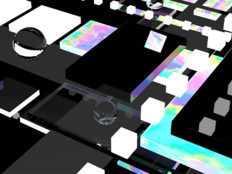Under the Microscope

Not too long ago, seriously ill patients, who don’t have a lot of time in their favor, would wait days, weeks or even months for a conclusive diagnosis of their condition. Yet now, through rapidly evolving digital pathology, these individuals are being diagnosed within hours — and sometimes minutes.
The small but rapidly growing field of digital pathology — the scanning, analysis, management and remote transfer of tissues and cell images — has made it possible for time-critical treatment decisions to be made much more quickly.
“It’s all about fast diagnosis and faster treatment,” explains Dr. Jared Schwartz, president of the College of American Pathologists. “With this new technology, pathologists can quickly scan and store a slide, and it’s instantly available via a server over a network or the Internet anywhere in the world, ready for quick analysis and diagnosis.”
The payoff goes without saying: A woman who has just been told she had an abnormal mammogram will know quickly what she is facing and be able to start treatment immediately. A child with an aggressive form of leukemia can get the specific treatment required without delay. Behind the scenes of a better and faster diagnosis lies an IP-based network and processing power that saves vital time.
“Not too long ago, it could take 20 minutes to scan a slide,” Schwartz continues. “Today, it’s a few minutes, and not too long from now it will be 30 seconds.”
Leading the Way
One leader in the field of digital pathology is Aperio Technologies in Vista, Calif. The company has spent the past 10 years perfecting its technology and making it accessible to medical professionals without requiring substantial investments in high-end hardware, storage or networking.
“Our vision is that digital pathology can dramatically increase the quality and efficiency of pathology services,” says Dirk Soenksen, Aperio’s CEO.
Aperio develops digital imaging capabilities that allow medical professionals to more easily and accurately manage and interpret human tissue samples. Its products, based on proprietary technology and algorithms, include custom scanning instruments, image management software, advanced visualization software and image analysis algorithms. Medical laboratories use these products to develop other instrumentation and medical therapies, while hospitals and medical professionals use them to diagnose patients.
The company’s high-resolution ScanScope scanner, for example, creates color digital slide images of glass slides. Aperio believes digital slides are superior to glass because they allow remote viewing, enable long-distance conferencing, enable better image analysis, and are easier to store and retrieve. ScanScope’s current iteration allows for very fast processing of slides — most of its scanners average less than 2 minutes per slide at 20x magnification.
Aperio’s unique Spectrum software tool allows users to view and manage large images (typical files range from 300 to 400 megabytes). It also offers a suite of tools for measuring and analyzing slides. The C++ software runs on the Windows XP platform and is built in an open fashion to allow partner pharmaceutical companies to integrate with it.
This helps health-care providers reduce the amount of bandwidth needed, which traditionally has been a challenge.
“The bandwidth required to transmit a digital pathology image is tremendous, so corporate IT departments are a little anxious at the moment about clogging up their pipes with these images that would be flowing back and forth,” Schwartz says.
Aperio has largely solved that problem through creative thinking and clever software. “It’s been a huge challenge for us, but we’ve been able to master it,” explains Ole Eichhorn, Aperio’s chief technology officer. “Our system works by sending only the data you request to your screen and anticipating where you want to go next. That way, we don’t have to send everything to you, which would be prohibitive.”
Because of its approach, Eichhorn says, the system works well with ordinary broadband connections. “If you have a 200 kilobyte connection like you would with DSL or a cable modem, you’ll be fine,” he says.
Listening and Learning
For Aperio, it’s only the beginning. The startup has come a long way since its inception in Soenksen’s three-car garage in 1999 — now known within the company as Suite G.
Achieving the goal of better, faster, intuitive digital pathology, however, involves doing more of what Aperio does best: listening to its customers and continuing to innovate. “We have 400 customers, and we use them as an ongoing source of feedback about customer needs and new opportunities, which we can feed into our product development,” Eichhorn says.
The company’s next innovation, now in pilot mode, is an offering called Second Slide, an online service for sharing digital slides. With this service, Soenksen hopes pathologists will be able to consult with each other more quickly and effectively, and that someday, individual patients will have greater control over their own medical care by having access to their data.
“We believe that digital pathology is at the center of major health-care trends,” Soenksen says. By adding the technology to existing radiology and cardiology image archiving systems, applying it to personalized medicine and using it to automate anatomic pathology laboratories, he says, digital pathology promises to increase diagnostic accuracy and patient safety.






